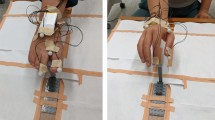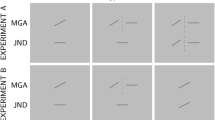Abstract
The general objective of this study was to compare the precise grasping behavior and intermanual differences in performance between three Pan paniscus and five Homo sapiens in grasping small objects. We compared the temporal pattern of two submovements of consecutive grasping cycles, the (visuomotor) reaching and the (sensorimotor) grasping. Both species were similarly successful in this task, they showed a behavioral right-hand preference and preferred specific types of grips. Bonobos required less time for reaching an object but a much longer time to grasp it than humans did. Thus, the species pursued different strategies. We assumed that this might be due to the different grip techniques. However, grip preferences did not serve a quicker intramanual performance but they pronounced differences between hands. Intermanual differences in timing were restricted to the reaching part and more strongly in bonobos than in humans. However, the right hand need not necessarily perform quicker. As in the case of humans, we assume that attentional cues were focused more on preparing a proper grip with the right hand than on a quick performance. However, strong intermanual differences in bonobos may indicate an overall stronger neuronal asymmetry in the motor organization of the finger musculature that prepare a proper grip than is true of humans.
Similar content being viewed by others
REFERENCES
Annett, M. (1992). Five tests of hand skill. Cortex 28: 583-600.
Arbib, M. A., Iberall, T., and Lyons D. (1985). Coordinated control programs of movements of the hand. In Goodwin, A. W., and Darian-Smith, I. (eds.), Hand Function and Neocortex. (Exp. Brain Res., Suppl. 10), Springer, Berlin, Heidelberg, New York, pp. 111-129.
Boesch, C. (1991). Handedness in wild chimpanzees. Int. J. Primatol. 12: 541-558.
Boesch, C., and Boesch, H. (1993). Different hand postures for pounding nuts with natural hammers by wild chimpanzees. In Preuschoft, H., and Chivers, D. J. (eds.), Hands of Primates. Springer, Wien, New York, pp. 91-108.
Bortoff, G. A., and Strick, P. L. (1993). Corticospinal terminations in two new-world primates: Further evidence that corticomotoneuronal connections provide part of the neural substrate for manual dexterity. J. Neurosci. 13(12): 5105-5118.
Brinkman, C. (1984). Supplementary motor area of monkey's cerebral cortex: Short and long term deficits after unilateral ablation and the effects of subsequent callosal section. J. Neurosci. 4: 918-929.
Brinkman, J., and Kuypers, H. G. J. M. (1973). Cerebral control of contralateral and ipsilateral arm, hand and finger movements in the split-brain rhesus monkey. Brain 96: 653-674.
Byrne, R. W., and Byrne, J. M. (1991). Complex leaf-gathering skills of mountain gorillas (Gorilla g. beringei): Variability and standardization. Am. J. Primatol. 31(4): 241-261.
Christel, M. (1993a). Grasping techniques and hand preferences in hominoidea. In Preuschoft, H., and Chivers, D. J. (eds.), Hands of Primates, Springer, Wien, New York, pp. 91-108.
Christel, M. (1993b). Greiftechniken und Handpräferenzen verschiedener catarrhiner Primaten beim Aufnehmen kleiner Objekte, Inaugural dissertation, FU Berlin.
Christel, M. I. (1994). Catarrhine primates grasping small objects—techniques and hand preferences. In Anderson, J. R., Roeder, J. J., Thierry, B., and Herrenschmidt, N. (eds.), Curr. Primatol., Vol. III. Behav. Neurosc. Physiol. Reprod., Université L. Pasteur, Strasbourg, pp. 37-50.
Colell, M., Segarra, M. D., and Sabater-Pi, J. (1995). Manual laterality in chimpanzees (Pan troglodytes) in complex tasks. J. Comp. Psychol. 109(3): 298-307.
Corballis, M. C. (1991). The Lopsided Ape: Evolution of the Generative Mind, Oxford University Press.
Darian-Smith, I., Galea, M. P., Darian-Smith, C., Sugitani, M., Tan, A., and Burman, K. (1996). In Beck, F., Kriz, W., Sano, Y., and Schiebler, T. H. (eds.), Advances in Anatomy Embryology and Cell Biology 133, Springer, Melbourne, Heidelberg, Kyoto, Würzburg.
Day, M. H., and Napier, J. R. (1963). The functional significance of the head of the Flexor pollicis brevis in primates. Folia Primatol. 1: 122-134.
Demes, B. (1991). Biomechanische Allometrie: Wie die Körpergröße Fortbewegung und Körperform von Primaten bestimmt. Cour. Forsch.-Inst. Senckenberg, Frankfurt.
Fagot, J., and Vauclair, J. (1991). Manual laterality in nonhuman primates: A distinction between handedness and manual specialization. Psychol. Bull., 109: 76-89.
Fisk, J. D., and Goodale, M. A. (1985). The organization of eye and limb movements during unrestricted reaching to targets in contralateral and ipsilateral visual space. Exp. Brain Res. 60: 159-178.
Finch, G. (1941). Chimpanzee handedness. Science 94: 117-118.
Fitts, P. M. (1954). The information capacity of the human motor system in controlling the amplitude of the movement. J. Exp. Psychol. 47: 381-391.
Heffner, R., and Masterton, B. (1975). Variation in form of the pyramidal tract and its relationship to digital dexterity. Brain Behav. Evol. 12(3): 161-200.
Hopkins, W. D. (1993). Posture and reaching in chimpanzees (Pan troglodytes) and orangutans (Pongo pygmaeus). J. Comp. Psych. 102: 248-250.
Hopkins, W. D., and de Waal, F. B. M. (1995). Behavioral laterality in captive chimpanzees (Pan paniscus): Replication and extension. Int. J. Primatol. 16: 261-276.
Hopkins, W. D., and Morris, R. D. (1993). Handedness in great apes: A review of findings. Int. J. Primatol. 14: 1-25.
Hopkins, W. D., Bennett, A. J., Bales, S. L., Lee, J., and Ward, P. J. (1993). Behavioral laterality in captive bonobos (Pan paniscus). J. Comp. Psych. 107(40): 403-420.
Igmanson, E. J. (1996). Hand-use preference among Pan paniscus at Wamba, Zaire. AAPA abstracts. Am. J. Phys. Anthropol. 22: 129.
Jeannerod, M. (1984). The timing of natural prehension movements. J. Motiv. Behav. 16(3): 235-254.
Jeannerod, M., Arbib, M. A., Rizzolatti, G., and Sakata, H. (1995). Grasping objects: The cortical mechanisms of visuomotor transformation. TINS 18(7): 314-320.
Jones-Engel, L., and Bard, K. A. (1996). Precision grips in young chimpanzees. Am. J. Primatol. 39(2): 1-15.
Kazennikov, O., Wicki, U., Corboz, M., Hyland, B., Palmeri, A., Rouiller, E. M., and Wiesendanger, M. (1994). Temporal structure of a bimanual goal-directed movement sequence in monkeys. Eur. J. Neurosci. 6: 203-210.
Keele, S. W. (1968). Movement control in skilled motor performance. Psychol. Bull. 70: 387-404.
Kuypers, H. G. J. M. (1981). The anatomy of the descending pathways. In Brooks, V. B. V., Brookhart, J. M., and Mountcastle, J. M. (eds.), Handbook of Physiology, Section 1. The Nervous System II (2), Am. Physiol. Society, Bethesda, MD, pp. 597-666.
Lehman, R. A. W. (1970). Hand preference and cerebral predominance in 24 rhesus monkeys. J. Neurol. Sci. 10: 185-192.
LeMay, M. (1985). Asymmetries of the brains and skulls of nonhuman primates. In Glick, S. D. (ed.), Cerebral Lateralization in Nonhuman Species, Academic Press, New York, pp. 223-245.
MacNeilage, P., Studdert-Kennedy, M. G., and Lindblom, B. (1987). Primate handedness reconsidered. Behav. Brain Sci. 10: 247-263.
Marchant, L. F., and McGrew, W. C. (1991). Laterality of function in apes: A meta-analysis of methods. J. Hum. Evol. 21: 425-438.
Marchant, L. F., and Steklis, H. D. (1986). Hand preference in a captive island group of chimpanzees (Pan troglodytes). Am. J. Primatol. 10: 301-313.
Marzke, M. (1997). Precision grips, hand morphology, and tools. Am. J. Phys. Anthropol. 102: 91-110.
Marzke, W. M., and Wullstein, K. L. (1996). Chimpanzee and human grips: A new classification with a focus on evolutionary morphology. Int. J. Primatol. 17: 117-139.
Muir, R. B. (1985). Small hand muscles in precision grip: A corticospinal prerogative. In Goodwin, A. W., and Darian-Smith, I. (eds.), Hand Function and Neocortex, Exp. Brain Res. Suppl. 10, Springer, Berlin, New York, pp. 155-174.
Napier, J. R. (1956). The prehensile movements of the human hand. J. Bone Joint Surg. Am. 38B: 902-913.
Napier, J. R. (1962). The evolution of the hand. Sci. Am. 12: 49-55.
Oldfield, R. C. (1971). The assessment and analysis of handedness: The Edinburgh inventory. Neuropsychologia 9: 97-113.
Pause, M., Kunesch, E., Binkofski, F., and Freund, H.-J. (1989). Sensorimotor disturbances in patients with lesions of the parietal cortex. Brain 112: 1599-1625.
Porter, R., and Lemon, R. (1993). Corticospinal function and voluntary movement. Monographs of the Physiological Society 45, Clarendon Press, Oxford.
Preuschoft, H. (1973). Functional anatomy of the upper extremity. In Bourne, G. H. (ed.), The Chimpanzee (6), Karger, Basel, Baltimore, pp. 34-115.
Sprankel, H., and Lorenz, R. (1984). P. troglodytes, Ergreifen kleiner Objekte, Film E 1796, Publ. Inst. Wiss. Film (IWF), Göttingen.
Susman, R. L. (1988). Hand of Paranthropus robustus from Member 1, Swartkrans: Fossil evidence for tool behavior. Science 240: 781-783.
Susman, R. (1995). Thumbs, tools, and early humans. Science 268: 586-589.
Sugiyama, Y., Fushimi, T., Sakura, O., and Matsuzawa, T. (1993). Hand preference and tool use in wild chimpanzees. Primates 34(2): 151-159.
Tonooka, R., and Matsuzawa, T. (1995). Hand preferences of captive chimpanzees (Pan troglodytes) in simple reaching for food. Int. J. Primatol. 16(1): 17-35.
Tuttle, R. H. (1965). A Study of the Chimpanzee Hand with Comments on Hominoid Evolution, University of California, Berkeley, University Microfilm, Ann Arbor, MI.
Tuttle, R. H. (1967). Knuckle-walking and the evolution of hands. Am. J. Phys. Anthropol. 26: 171-296.
Vieeschouwer, De K., Van Elsacker, L., and Verheyen, R. F. (1995). Effect of posture on hand preferences during experimental food reaching in bonobos (Pan paniscus). J. Comp. Psychol. 109(2): 203-207.
Wang, X., Merzenich, M. M., Sameshima, K., and Jenkins, W. M. (1995). Remodelling of hand representation in adult cortex determined by timing of tactile stimulation. Nature 378: 71-75.
Author information
Authors and Affiliations
Rights and permissions
About this article
Cite this article
Christel, M.I., Kitzel, S. & Niemitz, C. How Precisely Do Bonobos (Pan paniscus) Grasp Small Objects?. International Journal of Primatology 19, 165–194 (1998). https://doi.org/10.1023/A:1020319313219
Issue Date:
DOI: https://doi.org/10.1023/A:1020319313219




